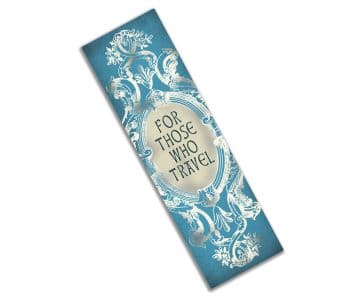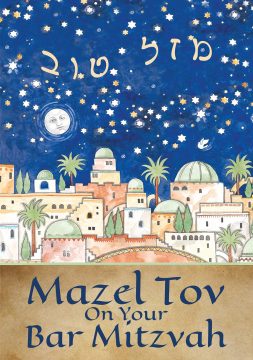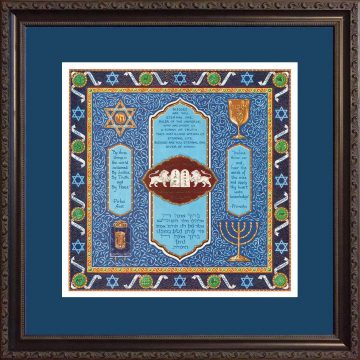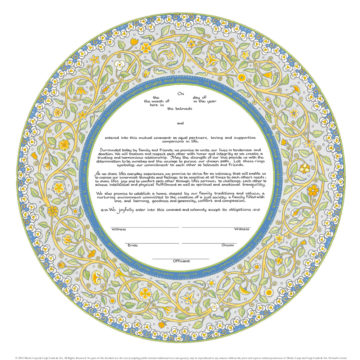- About the Artist
- About Caspi Cards & Art
- Ketubah History
- How do we choose a text?
- Translation of Orthodox Text
- Translation of Conservative Text
- Can we write our own text?
- How do we enter our Hebrew names on the Personalization Form?
- What if I don’t have a Hebrew name?
- Will my ketubah look exactly as I see it on my screen?
- Why is the time of the wedding significant?
- How long does it take to complete a Ketubah?
- What happens if there is a mistake on our ketubah?
- Can we receive a ketubah proof?
- How should we handle the ketubah during the ceremony?
- What type of pen should be used to sign the ketubah?
- How do we fill in a ketubah by ourselves?
- How should we display the ketubah in our home?
About the Artist
Mickie Caspi is an Israeli-American artist and calligrapher who has been specializing in Judaica since 1980. Her hundreds of original designs are reproduced on ketubot (Jewish Wedding Contracts), greeting cards, Judaic art prints, calendars and more. Among the many sources that inspire Mickie’s delicate watercolor designs are traditional Jewish motifs, Persian and Arabic illumination, contemporary graphics, as well as art nouveau and art deco. Being an avid gardener, she loves to incorporate the beauty of nature into much of her artwork.
Mickie studied art at Columbia College in Chicago where she discovered a love for the simple elegance of calligraphy. She spent seven years as a freelance artist and calligrapher in Israel. She currently resides in Newton, Massachusetts with her husband and business partner, Eran.
About Caspi Cards & Art
After years of creating original artwork for individual clients, Mickie decided to bring her creations to a larger audience. Together with her husband Eran, Mickie established Caspi Cards & Art in 1990. To better enable her to concentrate on the creative process, Eran took over the daily management of the business. Since that time, Caspi Cards & Art has innovated the ketubah business by offering dozens of ketubah designs in a variety of texts. We introduced the first pre-printed Interfaith text as well as a gender neutral text that could be used by same-sex couples. New for 2003, we wrote an all English Humanist text to be used by secular couples, as well as couples searching for a more modern interpretation of the ketubah text. And with the addition of our Giclee Ketubah line that uses fine art digital technology, we now offer a non-binary ketubah text and can print custom texts at no extra charge. Mickie and Eran also pride themselves on being able to meet any deadline (“Can you help me, I’m getting married tomorrow!”). Since 2000, Caspi Cards & Art has produced the Jewish Art Calendar, available at Jewish galleries & bookstores throughout the United States. In addition to ketubot and calendars, Caspi Cards & Art offers Mickie’s beautiful designs as framed prints, greeting cards, mezuzahs, and an extensive offering of car mezuzahs. All of Mickie’s artwork is available through your local Judaica store, galleries, synagogue stores, and online.
Ketubah History
THE KETUBAH – the marriage contract – was introduced into the Jewish wedding ceremony approximately 2,500 years ago. It was written in Aramaic, the spoken language of the Jews of the time, so that everyone would understand the contract. To this day Aramaic has remained the language of the traditional Ketubah. In the contract, the husband undertakes to honor, support and maintain his wife, and to live with her in affection and amity. He also states what she will receive in the event of divorce or of his death. The ketubah was developed to protect the Jewish wife and to ensure her future.
Although the traditional text has undergone little change through the centuries, couples today often prefer that the text portray their own spirituality. Mickie’s ‘Offset Lithograph’ ketubot are available with a variety of pre-printed texts from the traditional to the modern, to allow you to choose both a design and a text that best reflects your ideas and beliefs. And her line of ‘Giclee Ketubot’ allow a wider range of texts and the option for custom texts at no additional charge.
The ketubah document has attracted artistic adornment through the centuries and has become a significant expression of Jewish art. With the use of calligraphy to ornament the text itself and a vast host of designs to enhance and beautify the border, the ketubah has evolved into a unique document expressing a couple’s life together.
How do we choose a text?
Choosing a text can be as difficult as choosing a design. Mickie offers a large variety of different text choices ranging from the Traditional to the Modern. You should read through all of the texts and choose the one that best reflects your own beliefs and worldview. It would be wise to get your rabbi’s or officiant’s approval before ordering your ketubah (some rabbis might desire a particular text).
Please note, the texts of different ketubot come in different sizes and shapes. We usually show only one shape of our texts on the website so that you can read the actual text. Any traditional quote that appears on the text shown, might or might NOT appear on your actual ketubah. Even if you see a particular quote on the text that you choose, it might not appear on your actual ketubah. If you would like to know if a specific quote appears, please call us to confirm.
The Traditional Aramaic (Orthodox) text is a prenuptial agreement between the groom and the bride wherein the husband undertakes to honor, support and maintain his wife. In the document he states that she will receive a certain sum of money in the event of divorce or of his death. It is a formal contract written in Aramaic over 2000 years ago and originally was a valuable document that protected the bride. There is no English on this text. Click here to read a translation.
The Traditional Aramaic with English (Orthodox) text is a prenuptial agreement between the groom and the bride wherein the husband undertakes to honor, support and maintain his wife. In the document he states that she will receive a certain sum of money in the event of divorce or of his death. It is a formal contract written in Aramaic over 2000 years ago and originally was a valuable document that protected the bride. The English portion is NOT a translation of the Aramaic, but rather a contemporary text written by Mickie & Eran. Usually, witnesses sign in Hebrew under the Aramaic. Most ketubot with this text only have the Bride, Groom and Rabbi sign in English (not the witnesses). Click here to read a translation.
The Lieberman Clause with English (Conservative) text is almost the same text as the Traditional Aramaic. A new clause is added essentially stating that in the case of a civil divorce, either the husband or wife can appear before the Bet Din (rabbinic court) to request a “Get” (a Jewish divorce document). According to Jewish law, without this document, a woman is still legally married to her husband. If she wants to remarry and she doesn’t have a “Get”, any children that she would have with the second husband would be considered illegitimate. Conservative Rabbis often prefer the Lieberman Clause text to protect the woman in the unlikely event that a man refuses to grant her a “Get”, so please check with your rabbi first. Orthodox Rabbis do not accept the Lieberman Clause, so in fact it only relates to a Conservative Bet Din. The English portion is NOT a translation of the Aramaic, but rather a contemporary text written by Mickie & Eran. See FAQ below to read the Lieberman Clause addition used in the Conservative Text.
The Egalitarian Hebrew and English (Reform) text is suitable for reform weddings. Mickie and Eran wrote the English text and carefully translated it into modern, poetic Hebrew. It was modeled on the traditional text, yet reflects a more egalitarian view of Judaism and the equal roles of a husband and wife in our contemporary Jewish society.
The Interfaith with Hebrew heading text, was specifically written for couples of different heritages, although it has been used by Jewish couples who were raised in different traditions. It has a short Hebrew heading (a translation of the first English paragraph) where the bride and groom’s personal information is inscribed. This text was written by Mickie & Eran.
The Anniversary with Hebrew heading text is designed for couples celebrating an anniversary from 2 years to 70 or more years. It records the bride and groom’s original wedding and does not need to be signed. For couples who were married with a simple ketubah brought by a rabbi for the ceremony, a beautiful anniversary ketubah is now an option. Couples may decide to purchase a new ketubah for themselves in order to renew their vows, or they can receive one as a gift (often from their children). This text was written by Mickie & Eran.
The Alternative Egalitarian Hebrew and English (Reform) text is a second Reform text offered by Caspi Cards & Art and is suitable for reform, humanist, and interfaith weddings. The Hebrew is a direct translation of the English. We normally add signature lines for 2 Witnesses, Bride, Groom and Officiant, but you can ask for your own specific signature lines such as beloved, spouse or partner, or Rabbi or Cantor. If not specified, we will enter lines for 2 Witnesses, Bride, Groom and Officiant. This text was written by Mickie & Eran.
The Same Sex (Female) Hebrew and English text is the only ketubah specifically written with same sex male couples in mind. The Hebrew is a direct translation of the English. If not specified, we will add signature lines for 2 Witnesses, 2 Beloveds and 1 Officiant. If you desire different signature lines, such as spouse, partner, bride, Rabbi or Cantor, please request this when you fill out the Personalization Form. This text was written by Mickie & Eran in 1995 to fill a need in the market at a time when very few artists were offering same sex texts.
The Same Sex (Male) Hebrew and English text is the only ketubah specifically written with same sex male couples in mind. The Hebrew is a direct translation of the English. If not specified, we will add signature lines for 2 Witnesses, 2 Beloveds and 1 Officiant. If you desire different signature lines, such as spouse, partner, groom, Rabbi or Cantor, please request this when you fill out the Personalization Form. This text was written by Mickie & Eran in 1995 to fill a need in the market at a time when very few artists were offering same sex texts.
The Non-Binary Hebrew and English text is for weddings where one or both partners identify as non-binary. The Hebrew is a direct translation of the English. Since Hebrew is a gendered language, the endings of certain words follow the Nonbinary Hebrew Project usage. If not specified, we will add signature lines for 2 Witnesses, 2 Beloveds and 1 Officiant. If you desire different signature lines, such as spouse, partner, groom, bride, Rabbi or Cantor, etc. Please request this when you fill out the Personalization Form. This text was originally written by Mickie & Eran in 1995, and updated using non-gendered words in Hebrew, and is available on any ‘Giclee Ketubah’ or ‘Simple Text Ketubah’.
The Humanist English only text was written for couples who prefer not to have any Hebrew on the ketubah. It is suitable for humanist or secular ceremonies, as well as for interfaith couples. This text was written by Mickie & Eran
The Traditional Aramaic text is usually based on the Ashkenazi tradition. For those seeking a Sephardic (Orthodox) text, we offer the option on our Fine Art Digital Giclee and Simple Text Ketubot. Because there are many versions of the Sephardic text, and since individual Rabbis have specific requirements for the personalization, if you order a Sephardic text, you will need to send us a digital completed text to use for your ketubah.
If you are a couple that would like to write your own text, Mickie can hand-calligraph any original text onto an Offset Lithograph Ketubah of your choice. There is an extra cost of $2.00/word, with a $400 minimum, in addition to the cost of the ketubah. We would be happy to discuss this option – you can call us at 1-800-538-8268 at your convenience. Or, for a more affordable option, you can choose a Giclee Ketubah and submit your own Custom Text in an editable, digital format for Mickie to add to your individually printed fine art digital ketubah at no extra cost.
All of the texts were carefully composed to meet the different needs of couples expressing the many various forms of Judaism today. Please note that all of our texts are copyrighted and registered with the Library of Congress and may not be reproduced without our express written permission.
Translation of Orthodox Text
On the (day of week) day of the week, the (day of month) day of the (name of in the year five thousand seven hundred and (current year) since the creation of the world, the era according to which we reckon here in (location of wedding) that (groom’s name) son of (groom’s parents’ names) said to this (brides’ status) (bride’s name) daughter of (bride’s parents’ names), “Be my wife according to the practice of Moses and Israel, and I will cherish, honor, support and maintain you in accordance with the custom of Jewish husbands who cherish, honor, support and maintain their wives faithfully. And I here present you with the marriage gift of (__________) silver zuzim, which belongs to you, according the law of Moses and Israel; and I will also give you your food, clothing and necessities, and live with you as husband and wife according to universal custom.” And (bride’s name), this (bride) consented and became his wife. The trousseau that she brought to him from her (father’s/own) house in silver, gold, valuables, clothing, furniture and bedclothes, all this (groom’s name), the said bridegroom accepted in the sum of (one hundred) silver pieces, and (groom’s name) the bridegroom, consented to increase this amount from his own property with the sum of (one hundred) silver pieces, making in all (two hundred) silver pieces. And thus said (groom’s name), the bridegroom: “The responsibility of this marriage contract, of this trousseau, and of this additional sum, I take upon myself and my heirs after me, so that they shall be paid from the best part of my property and possession that I have beneath the whole heaven, that which I now possess or may hereafter acquire. All my property, real and personal, even the shirt from my back, shall be mortgaged to secure the payment of this marriage contract, of the trousseau, and of the addition made to it, during my lifetime and after my death, from the present day and forever.” (groom’s name), the bridegroom, has taken upon himself the responsibility of this marriage contract, of the trousseau and the addition made to it, according to the restrictive usages of all marriage contracts and the additions to them made for the daughters of Israel, according to the institution of our sages of blessed memory. It is not to be regarded as a mere forfeiture without consideration or as a mere formula of a document. We have followed the legal formality of symbolic delivery kinyan between (groom’s name) son of (groom’s parents’ names) , the bridegroom and(bride’s name) daughter of (bride’s parents’ names) this (brides’ status), and we have used a garment legally fit for the purpose, to strengthen all that is stated above, and everything is valid and binding.
Attested to________________________ Witness
Attested to________________________ Witness
Translation of Conservative Text
This clause is added to the Orthodox text:
And the groom and the bride further agree that if this marriage shall ever be dissolved under civil law, then either husband or wife may invoke the authority of the Beth Din of the Rabbinical Assembly and the Jewish Theological Seminary of America or its duly authorized representatives, to decide what action by either spouse is then appropriate under Jewish matrimonial law; and if either spouse shall fail to honor the demand of the other or to carry out the decision of the Beth Din or its representative, then the other spouse may invoke any and all remedies available in civil law and equity to enforce compliance with the Beth Din’s decision and this solemn obligation.
Can we write our own text?
All of Mickie’s ‘Offset Lithograph’ ketubot are available blank so that we can individually calligraph your own custom text into the design of your choice. You will need to type the English portion of your text exactly as you wish it to appear on the ketubah. If you want Hebrew on your custom text, you will have to have the Hebrew portion translated and either typed in Hebrew, or written out very neatly by hand.
Please allow 4 to 6 weeks to complete. The cost of custom texts is $2.00 per word, with a $400 minimum charge. Since custom texts are so much work, we do have rush charges – within 3 weeks, add 20% & within 10 days, add 40%. For more information regarding custom texts, please call 1-800-KETUBOT (1-800-538-8268).
For a more affordable option, you can choose any ‘Giclee Ketubah’ or ‘Simple Text Ketubah’ and send us an editable, digital file of your text to print on the design of your choice for no additional charge.
How do we enter our Hebrew names on the Personalization Form?
When you are filling out the information form to order a ketubah, you will notice that when we ask for Hebrew names, you can only type in English. Here are several options for entering your Hebrew names:
- Transliterate the name from Hebrew to English and type in English letters. Example: Mordechai. We will then write Mordechai in Hebrew on the ketubah where it is called for. There is only one proper spelling for many Hebrew names. If you have a specific spelling for a name in Hebrew that is different from the commonly accepted spelling please let us know! You can write us a note at the bottom of the information form in the space reserved for extra comments or questions or you can call us at 1-800-KETUBOT (1-800-538-8268)
- You can use any online Hebrew keyboard (or use the link on the online personalization form we provide) to copy and paste Hebrew letters.
- If you don’t know the name in Hebrew or if someone does not have a Hebrew name, we can transliterate the English name into Hebrew. Write “transliterate” in the box that asks for the Hebrew name. Example: If the name is Richard, we will write Richard in Hebrew letters. A person reading the Hebrew will read the Hebrew letters as Richard.
- You can print out the information form and write the Hebrew names in the proper places (clearly and legibly) -or- you can call us at 1-800-KETUBOT (1-800-538-8268) and we will send you an information form that you can fill out in pen and return to us.
What if I don’t have a Hebrew name?
There is a space on all of our ketubot for Hebrew names. If you don’t have a Hebrew name, please write “transliterate” in the appropriate box and we will write your English name in Hebrew letters. Please do not leave the box blank, or write “none” or “N/A” as this will lead to a phone call from us asking for your Hebrew name. If you prefer to omit a name (in Hebrew or English), please specifically write ‘Omit’ in the appropriate space.
Will my ketubah look exactly as I see it on my screen?
Although the ketubah will look very similar, it will not be exactly as you are viewing it. Different monitors and display settings will affect the color, as well as the fact that the computer screen is a very different medium than ink on paper. The actual ketubah also has a finer, more delicate feel to it. And finally, the gold foil that appears on many of the ‘Offset Lithograph’ ketubot cannot be produced accurately (if at all) on your computer screen.
Why is the time of the wedding significant?
In the Hebrew calendar, the day begins and ends at sunset. Although Shabbat is on Saturday, we actually begin observing with the setting of the sun on Friday evening. Holiday celebrations also begin at sundown of the previous day. If your wedding takes place after sunset, the Hebrew date for the wedding is actually the following Hebrew day. When filling out the form, enter the English date and whether the wedding takes place before or after sundown, and we will look up the Hebrew date for you.
How long does it take to complete a Ketubah?
From the day we receive your completed form, please allow two weeks for us to personalize and ship your ketubah . If you need it sooner, just let us know. We can usually complete your ketubah within a day if necessary (without any rush charges, although you will be responsible for the extra cost of express shipping). If it is a rush ketubah, please call 1-800-KETUBOT (1-800-538-8268) and make sure that we have received your e-mail! For a custom text (a text that you have written and want us to calligraph into one of our designs), please allow 4 to 6 weeks to complete. The length of time to complete a ketubah will be delayed if you do not approve any requested proofs in a timely manner.
What happens if there is a mistake on our ketubah?
Please fill in your form carefully and have the rabbi or officiant approve it. We cannot be responsible for any mistakes you make in filling out the form. Please make sure we can reach you during the day by phone for any questions we might have. We will send you a proof to review and approve to make sure everything is correct. Once approved and completed, any mistakes will be your responsibility. If we need to create a new ketubah for you, you will need to purchase it.
Helpful Hint: Check again that everything is correct, especially the spelling of the name of your mother-in-law to be.
Can we receive a ketubah proof?
With new fine art digital printing technology, we offer a ketubah proof for all Giclee and Simple Text ketubah orders. For our offset lithographs, we continue to fill in each ketubah by hand with beautiful calligraphy. All Ketubah Personalization Hand Calligraphy is done personally by Mickie. We strongly recommend that when you purchase one of Mickie’s Ketubot, you also choose to have her personalize your ketubah.
Mickie 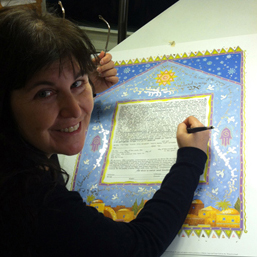 fills in all of the blank spaces in pencil to line up your information (names, date, location, etc). Since the information can be of varying length, Mickie will make sure that it fits aesthetically. When necessary, she will add curlicues to fill up the extra space. Eran will then proof the ketubah prior to Mickie completing the customization process in ink. Her goal is to match the hand calligraphy as closely as possible to the printed text.
fills in all of the blank spaces in pencil to line up your information (names, date, location, etc). Since the information can be of varying length, Mickie will make sure that it fits aesthetically. When necessary, she will add curlicues to fill up the extra space. Eran will then proof the ketubah prior to Mickie completing the customization process in ink. Her goal is to match the hand calligraphy as closely as possible to the printed text.
If you and/or your Rabbi/officiant would like a ketubah proof, please request it on the Ketubah Personalization Form. Before Mickie completes the customization, we can scan your ketubah after all of your personal info has been penciled. To create the proofs adds significant time and effort on our part when preparing an Offset Lithograph Ketubah. We are happy to scan and email you a pdf file as a proof when requested at no additional charge. However, if you make any changes to the ORIGINAL information supplied (not a correction to a mistake we have made), then an additional fee will be assessed depending on how extensive the change is.
How should we handle the ketubah during the ceremony?
Since the ketubah is actually read during the ceremony, many couples like to display it on an easel. We recommend that you bring the ketubah (you will receive it rolled in a tube) to a framer and ask them to mat it for you. Ask the framer to place a sheet of acetate over the ketubah to protect it from dirty hands. The matted ketubah can be placed on an easel during the ceremony and reception to add a splash of color and tradition. You can complete the framing process after the ceremony.
Helpful Hint: Appoint someone reliable at the wedding (a position of honor for someone?) to be in charge of the ketubah. This way you will be sure that it is not accidentally left behind at the end of the celebration, or worse, trampled or lost.
What type of pen should be used to sign the ketubah?
You can use any pen with indelible ink. We strongly discourage the use of fancy fountain or ink pens since these tend to leak, especially when people are not used to writing with them. We have seen horrible ink accidents. Choose a trusty medium ball point pen (any color, although many couples prefer black) to give the ketubah the look of a signed document, which is what it is.
We have found that the uni-ball Jetstream Stick Roller Ball Pens, Fine Point, Black Ink work very well and dry quicker than other pens to reduce the chance of smudging.
Helpful Hint: Practice signing your Hebrew names on a different piece of paper before you sit down to sign the actual ketubah (English names also if you need to).
How do we fill in a ketubah by ourselves?
If you would like Mickie to fill in your ketubah, please call us or fill in our online Personalization Form. If your rabbi, cantor or officiant is filling in your ketubah as a contract, we recommend using a black, medium ball point pen. If you are using your own calligrapher to fill in the ketubah, please note that your calligrapher must take full responsibility for any damage done to the ketubah.
To the calligrapher: Among other pens, we have used a Rotring Art Pen with Black Ink Cartridge and a matching nib (depending on the text, we use 1 of 5 different size nibs). If you pencil in guidelines first, please note that erasing pencil marks will remove the coating on the paper and can damage the pre-printed text and art. Erasing is very, very tricky – try not to erase on the pre-printed text at all, as little as possible in general, and as lightly as possible when necessary. We use Hi-Polymer erasers such as Pentel or Staedtler-Mars. You can experiment on the edges of the paper in order to get a feel for how your ink and pen work on the paper.
We strongly recommend that you have us complete the ketubah personalization for you.
How should we display the ketubah in our home?
After framing the ketubah with acid-free matting and backing, as well as UV protection or archival quality glass, you can hang your ketubah in your home. Please do not subject the ketubah to direct sunlight or bright indoor lights, as these can damage the ketubah and lead to fading.
